

History of the Earth: About. Natural Selection - Natural Selection, Evolution, Mutation. Topics Mutation Genetics Selection Description Explore how organisms with different traits survive various selection agents within the environment. Sample Learning Goals Determine which mutations are favored by the selection agents of predators and food variety and which mutations are neutral. Version 1.1.1 HTML5 sims can run on iPads and Chromebooks, as well as PC, Mac, and Linux systems. iPad: iOS 12+ SafariiPad compatible sims Android: Not officially supported.
Chromebook: Latest version of Google Chrome The HTML5 and Flash PhET sims are supported on all Chromebooks.Chromebook compatible sims Windows Systems: Microsoft Edge, latest version of Firefox, latest version of Google Chrome. The Insect Predation Game: Evolving Prey Defenses and Predator Responses (Synopsis) What is the interplay between competition, predator-prey interactions, and sequential evolution of prey defenses and predator responses?
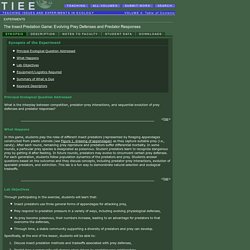
In this game, students play the roles of different insect predators (represented by foraging appendages constructed from plastic utensils (see Figure 1, drawing of appendages) as they capture suitable prey (i.e., candy). After each round, remaining prey reproduce and predators suffer differential mortality. In some rounds, a particular prey species is designated as poisonous. Student predators learn to recognize dangerous prey by getting ill after feeding. In future rounds, predators may evolve to circumvent certain prey defenses.
Natural Selection Game, by Michael Zito (model ID 3947) Do you have questions or comments about this model?
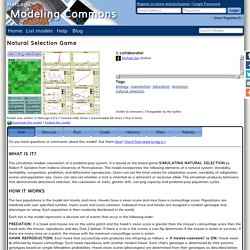
Ask them here! Big History Project: Humans. What Is The Great Story? "We must live as though we are setting the pattern for the future.
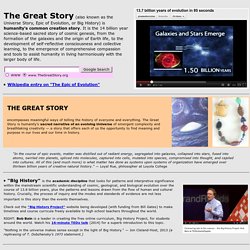
At any moment, we may be. How the present period of human inflation ends will determine whether the stable period that is coming will be dark and repressive or will nurture the human spirit. It may sound terribly overwhelming and even unfair that so much responsibility for the future rides on every decision we make. A voyage round the world. YouTube. About. Introduction Wikispaces Classroom is a social writing platform for education.

Untitled 1. Rapid evolutionary innovation during an Archean Genetic Expansion. Massachusetts Institute of Technology (MIT) scientists have deciphered the evolution of 3 billion year old genomes.
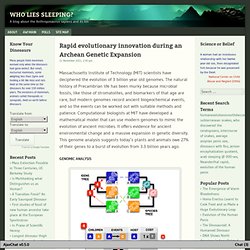
The natural history of Precambrian life has been murky because microbial fossils, like those of stromatolites, and biomarkers of that age are rare, but modern genomes record ancient biogeochemical events, and so the events can be worked out with suitable methods and patience. Computational biologists at MIT have developed a mathematical model that can use modern genomes to mimic the evolution of ancient microbes. It offers evidence for ancient environmental change and a massive expansion in genetic diversity. This genome analysis suggests today’s plants and animals owe 27% of their genes to a burst of evolution from 3.3 billion years ago.
Genomic Analysis Genenome Analysis: Reconciliation Method. Unpacking the past: Identifying a key evolutionary step in E. coli metabolism. (Phys.org) —Evolution is a process that takes place over long periods of time over which genetics and ecology may interact, producing novel phenotypic traits.
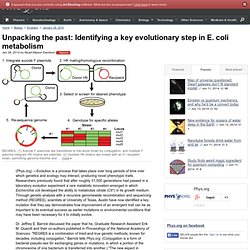
Researchers previously found that after roughly 31,500 generations had passed in a laboratory evolution experiment a rare metabolic innovation emerged in which Escherichia coli developed the ability to metabolize citrate (Cit+) in its growth medium. Through genetic analysis with a recursive genomewide recombination and sequencing method (REGRES), scientists at University of Texas, Austin have now identified a key mutation that they say demonstrates how improvement of an emergent trait can be as important to its eventual success as earlier mutations or environmental conditions that may have been necessary for it to initially evolve. Dr. Unraveling the Tree of Life. The Tree of Life: Tangled Roots and Sexy Shoots Tracing the genetic pathway from the Last Universal Common Ancestor to Homo sapiens Chris King - Genotype 1.2.8 - 4 Mar 2014 PDF Active site: Abstract: This article is a fully referenced research review to overview progress in unraveling the details of the evolutionary Tree of Life, from life's first occurrence in the hypothetical RNA-era, to humanity's own emergence and diversification, through migration and intermarriage, using research diagrams and brief discussion of the current state of the art, in response to summaries of some of these developments (Lawton 2009, Lane 2009).
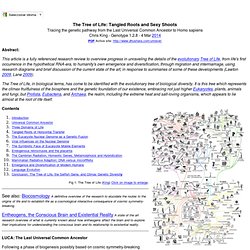
'Parallel universe' of life in oceanic crust could be Earth's largest ecosystem. Deep beneath the ocean floor off the Pacific Northwest coast, scientists have described the existence of a potentially vast realm of life, one almost completely disconnected from the world above.

Persisting in microscopic cracks in the basalt rocks of Earth's oceanic crust is a complex microbial ecosystem fuelled entirely by chemical reactions with rocks and seawater, rather than sunlight or the organic byproducts of light-harvesting terrestrial and aquatic ecosystems. Such modes of life, technically known as chemosynthetic, are not unprecedented, having also been found deep in mine shafts and around seafloor hydrothermal vents. Never before, though, have they been found on so vast a scale. In pure geographical area, these oceanic crust systems may contain the largest ecosystem on Earth. Mmbr.asm.org/content/75/2/361.full.pdf. Huge hidden biomass lives deep beneath the oceans - environment - 22 May 2008. It's the basement apartment like no other.
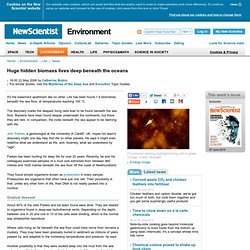
Life has been found 1.6 kilometres beneath the sea floor, at temperatures reaching 100 °C. The discovery marks the deepest living cells ever to be found beneath the sea floor. Www.pnas.org/content/95/12/6578.full.pdf. 'Parallel universe' of life in oceanic crust could be Earth's largest ecosystem. Microbiology of the Terrestrial Deep Subsurface - Penny S. Amy, Dana L. Halderman. Do ants really have the largest biomass of all species on earth? (Laurie, USA) - Ant Blog. Www.pnas.org/content/95/12/6578.full.pdf. Origins: Elizabeth Pennisi: September 2009 Archives.
By Elizabeth Pennisi As social as humans are, their cooperative nature pales in comparison to that of ants, bees, wasps, and termites (see hill, left).
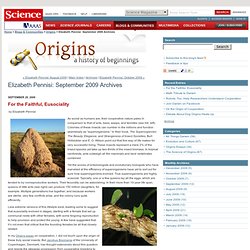
Colonies of these insects can number in the millions and function seamlessly as “superorganisms.” In their book, The Superorganism: The Beauty, Elegance, and Strangeness of Insect Societies, Burt Hölldobler and E. O. Elizabeth Pennisi writes about Richard Lenski's long-term evolution experiment. Elizabeth Pennisi has written about the long-term evolution experiment of Richard Lenski [The Man Who Bottled Evolution]. The experiment is in it's 25th year and it is entirely appropriate that Science magazine devotes several pages to describing the results.
Free and Safe Text Messaging for Teachers. Project Gallery. Google. Untitled. Flipgrid Terms of Service University of Minnesota College of Education and Human Development Learning Technology Media Lab (LTML) Last updated December 9, 2013. National Science Foundation (NSF) Events - Science: Becoming the Messenger.
Event Science: Becoming the Messenger Limited to Institutions & Universities in Kansas--More workshops will be offered in other locations January 27, 2011 7:30 AM to January 27, 2011 6:00 PM The Oread, Lawrence View video The National Science Foundation (NSF) will be holding a workshop, "Science: Becoming the Messenger" on January 27, 2011, at The Oread near the campus of the University of Kansas in Lawrence. Brain Games & Brain Training - Lumosity. PCR primer design: primers4clades tutorial. Population Reference Bureau. Gabe Zichermann. Science-based solutions to real-world problems in our community. Materials Science and Engineering. Darwin Online. Principles of Evolution, Ecology and Behavior. Syllabus Professor Stephen C. Stearns, Edward P. Bass Professor of Ecology and Evolutionary Biology Description This course presents the principles of evolution, ecology, and behavior for students beginning their study of biology and of the environment.
Evolution of Evolution - 150 Years of Darwin's "On the Origin of Species" Text-only | Flash Special Report Evolution of Evolution - 150 Years of Darwin's "On the Origin of Species" Introduction Charles Darwin. Evolution Resources from the National Academies. Freeman/Herron, Evolutionary Analysis, 4th Edition. An Introduction to Biological Evolution. Evolution: Second Edition. Exploring Life's Origins: A Virtual Exhibit. Prehistoric Time Line, Geologic Time Scale, Photos, Facts, Maps, and More. Www.johnkyrk.com/evolution.swf. Darwin Pond. Evolution Lab. Bacteria Simulator 2. Evolution.
Understanding Evolution. The bacteria that changed the world - May, 2017 The make-up of Earth's atmosphere, once the domain of Earth science textbooks, has become an increasingly "hot" news topic in recent decades, as we struggle to curb global warming by limiting the carbon dioxide that human activity produces. While the changes that humanity has wrought on the planet are dramatic, this isn’t the first time that one species has changed Earth’s atmosphere.
Three billion years ago, there was no free oxygen in the atmosphere at all.